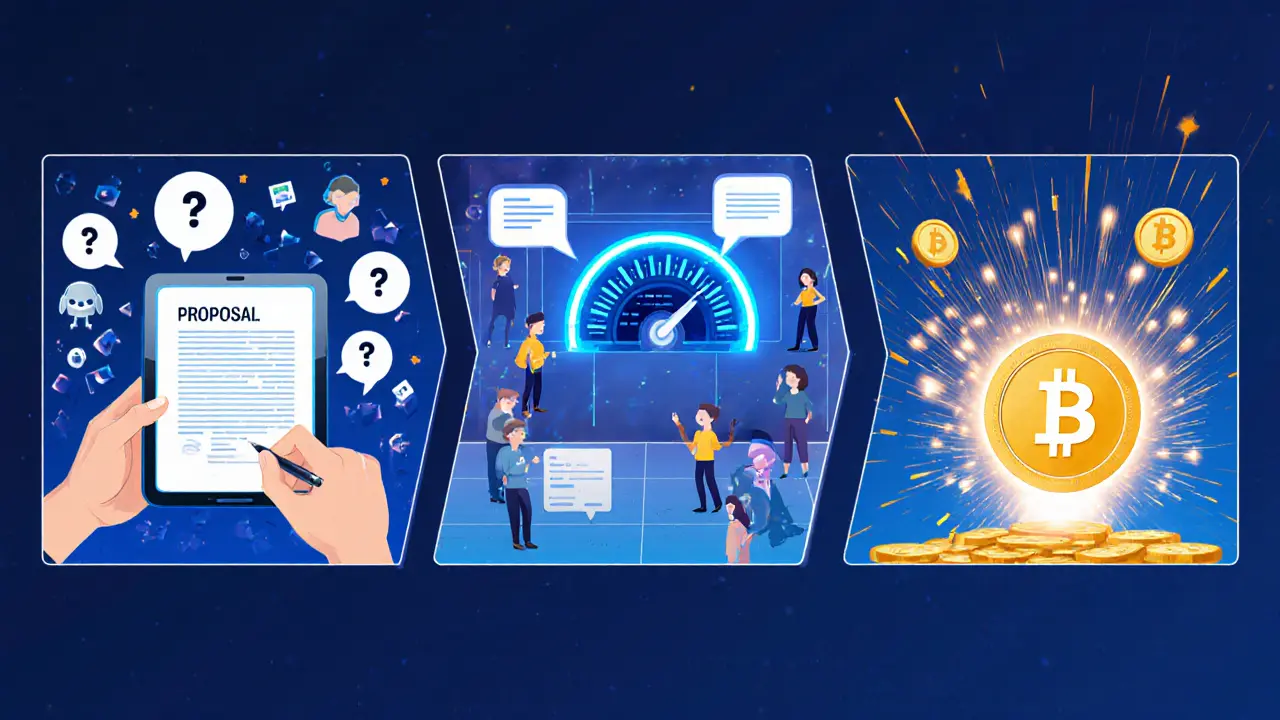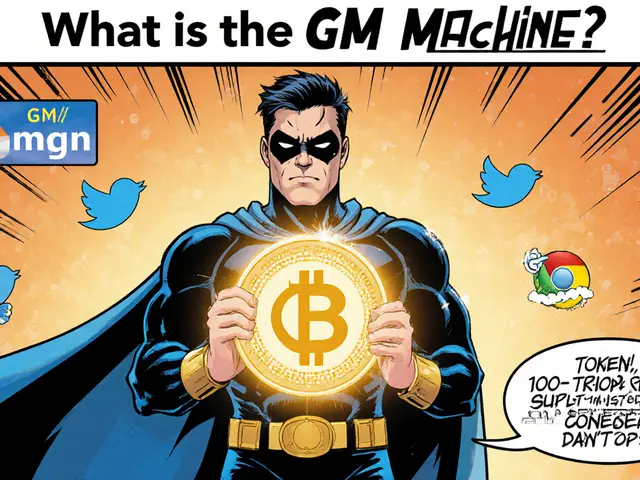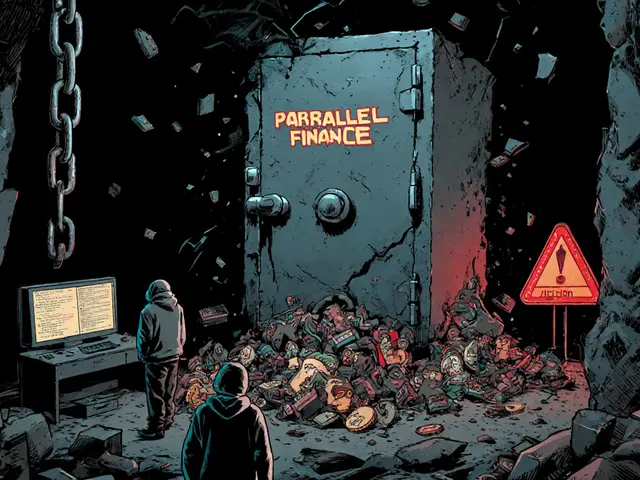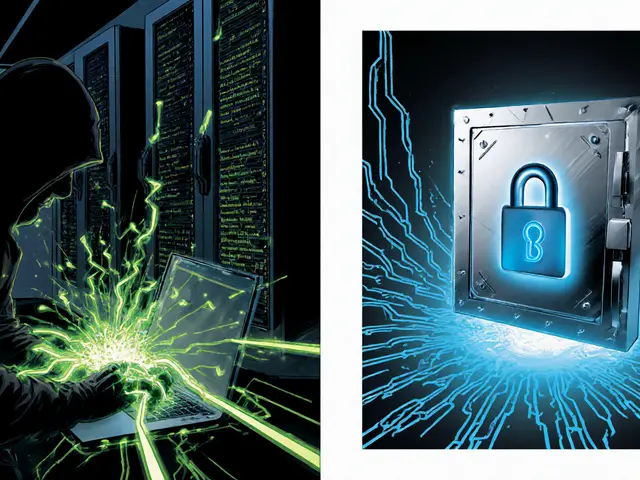How DAO Governance Works: A Simple Guide to Decentralized Decision‑Making
DAO Voting Power Calculator
Token Distribution Input
Enter your token holdings to see voting power distribution
Voting Model Selection
Results
Enter token holdings and select a voting model to see results
Key Takeaways
- A DAO runs on immutable smart contracts that encode its rules.
- Members submit proposals, discuss them, vote, and let code execute the outcome automatically.
- Voting power comes from governance tokens; the more tokens you hold, the more influence you have.
- Different DAO voting models (relative majority, rage‑quit, quadratic, conviction) balance speed, fairness, and resistance to "whale" dominance.
- Real‑world DAOs like ENS, ConstitutionDAO, and Juicebox show how these pieces fit together in practice.
Ever wondered how a group of strangers can run a billion‑dollar treasury without a CEO or boardroom? The answer lies in DAO governance. Instead of a handful of executives signing checks, the rules are baked into code, and token holders collectively decide the next move. This article walks you through every moving part, from the moment a proposal is drafted to the instant a smart contract flips a switch on the blockchain.
What Is a DAO?
Decentralized Autonomous Organization (DAO) is a digital collective that lives on a blockchain. Its bylaws, treasury, and decision‑making procedures are encoded in smart contracts. Because these contracts are public, anyone can audit how the organization works before joining.
Think of a DAO as a software‑driven corporation: shares are replaced by governance tokens, and board meetings become on‑chain votes. The difference is that control isn’t concentrated in a single office; it’s distributed among all token holders worldwide.
The Four Pillars of DAO Governance
- Proposals: Any member can draft a change-e.g., fund a grant, upgrade a protocol, or modify token economics.
- Voting Mechanisms: The community decides whether the proposal passes, using models like simple majority, quadratic, or conviction voting.
- Governance Tokens: These represent voting power. Holding more tokens gives you a bigger say, but token distribution design can curb excessive influence.
- Smart Contract Execution: Once a vote reaches the required threshold, the associated contract automatically carries out the decision-no human hand needed.
Each pillar interacts with the others. For example, a token‑weighted vote can only succeed if the underlying smart contract checks the token balance during execution.
Step‑by‑Step: The Proposal Lifecycle
- Draft: A member writes a proposal detailing the goal, required resources, and any technical changes.
- Discussion: The draft is posted on a forum (Discord, Discourse, or a governance portal). Community members ask questions, suggest edits, and gauge sentiment.
- Voting Period: After a sponsorship or timing trigger, token holders cast votes. The voting model determines how weight is counted.
- Result Evaluation: The smart contract tallies votes on‑chain. If the threshold is met, the proposal is marked as approved.
- Automatic Execution: The pre‑programmed smart contract executes the approved action-e.g., transfers funds, updates a parameter, or creates a new sub‑DAO.
This pipeline eliminates the need for trusted intermediaries; the code itself enforces the outcome.

Voting Models: Pros, Cons, and When to Use Them
| Model | How Votes Count | Key Strength | Main Trade‑off |
|---|---|---|---|
| Relative Majority (Permissioned) | Simple token‑weight sum; no quorum. | Fast, low gas cost. | Vulnerable to single‑member or whale control. |
| Rage‑Quit | Proposal must be sponsored; after approval a grace period lets voters withdraw support. | Mitigates majority dominance. | Long voting windows; may stall urgent decisions. |
| Quadratic Voting | Cost = (votes)^2; diminishing returns for large holders. | Reduces whale influence. | More complex UI; higher transaction fees. |
| Conviction Voting | Votes accrue over time; continuous support builds conviction score. | Encourages long‑term backing. | Slower to pass time‑sensitive proposals. |
Choosing a model is a trade‑off between speed, fairness, and resistance to centralization. Many DAOs start with relative majority for early‑stage agility and later adopt quadratic or conviction voting as the community matures.
Governance Tokens: The Currency of Influence
Governance tokens are minted during the DAO’s fundraising round (often an IDO or token sale). Holders automatically receive voting rights proportional to their balance. However, token design matters:
- Distribution: A wide airdrop or vesting schedule reduces “whale” concentration.
- Lock‑up & Staking: Requiring tokens to be staked for voting can align incentives and lower the chance of rapid sell‑offs after a vote.
- Burn & Mint Mechanics: Some DAOs allow token burning to signal long‑term commitment, while others mint new tokens to fund community grants.
Because token price often reflects perceived governance power, token economics intertwine with the DAO’s broader financial health.
Smart Contracts: The Execution Engine
All DAO rules live in smart contracts deployed on a blockchain such as Ethereum, Solana, or NEAR. These contracts are immutable once published-any change must go through the same governance process that updates other parts of the DAO.
Key contract types include:
- Treasury Contract: Holds the DAO’s funds and enforces withdrawal limits.
- Voting Registry: Tracks proposal metadata and tallies votes in real time.
- Token Contract: Manages minting, burning, and transfer of governance tokens.
- Execution Proxy: Calls external contracts once a proposal passes, maintaining a single point of authority.
Because execution is automatic, the DAO can react instantly to market changes-e.g., reallocating liquidity to a new pool the moment a majority approves it.

Real‑World DAO Examples
Seeing the theory in action helps cement the concepts:
- ENS DAO: Governs the Ethereum Name Service. Token holders vote on name‑registry upgrades and fund community grants.
- ConstitutionDAO: Launched a one‑off campaign to buy a historic US Constitution copy. It showcased rapid fundraising, a high‑profile proposal, and a swift voting window.
- Friends With Benefits (FWB) DAO: A social DAO where members vote on event funding, NFT drops, and cultural initiatives.
- JuiceboxDAO: Provides a framework for crowdfunding; its governance tokens decide treasury splits and protocol upgrades.
Each DAO tailors the four pillars-proposal, voting, token, contract-to its mission, proving the model’s flexibility.
Challenges and How DAOs Tackle Them
Despite the hype, DAOs face real hurdles:
- Whale Dominance: Large token holders can sway outcomes. Solutions include quadratic voting, token caps, and vesting.
- Low Participation: Many token holders stay idle, letting a tiny active minority decide. DAOs combat this with participation incentives (e.g., voting rewards) and clear, low‑friction voting interfaces.
- Security Risks: Bugs in smart contracts can lock or steal funds. Audits, formal verification, and modular contract design mitigate these risks.
- Governance Fatigue: Constant proposals can overwhelm members. Implementing proposal filters or requiring sponsorship helps keep the pipeline manageable.
Addressing these issues is an ongoing process; many DAOs iterate on their governance models as the community grows.
Future Outlook: Scaling DAO Governance
As DAOs attract more users, scalability becomes crucial. Layer‑2 solutions (e.g., Optimism, Arbitrum) lower gas fees, making frequent voting affordable. Polycentric governance-multiple overlapping DAOs coordinating on shared resources-offers a way to handle complex ecosystems without a single point of failure.
In the next few years, expect more hybrid models where on‑chain voting coexists with off‑chain deliberation (e.g., snapshot voting combined with Discord discussions). The core idea stays the same: code enforces the agreed‑upon rules, and token holders drive the direction.
Quick Checklist for New DAO Participants
- Read the DAO’s governance token whitepaper to understand distribution and voting power.
- Familiarize yourself with the DAO’s smart contract addresses-verify them on a block explorer.
- Start with low‑stake proposals or “comment‑only” votes to learn the discussion culture.
- Check if the DAO uses a sponsorship step; you may need an ally to get your idea on the ballot.
- Keep an eye on gas fees; timing your vote during low‑usage periods saves money.
What is the difference between a DAO and a traditional company?
A DAO replaces a board of directors with on‑chain code and token‑weighted voting. Ownership is public, and decisions execute automatically, whereas a traditional company relies on a few executives and manual paperwork.
How can I join a DAO?
Typically you acquire the DAO’s governance token-through a sale, airdrop, or exchange-then connect a crypto wallet to the DAO’s governance portal to start voting or proposing.
What voting model is best to prevent whale control?
Quadratic voting reduces the impact of large token balances by making each additional vote cost exponentially more. Some DAOs combine it with token caps or vesting schedules for extra safety.
Can a DAO change its smart contracts after deployment?
Yes, but only through a governance proposal that passes the required voting threshold. The upgrade logic itself must be built into an upgradeable contract pattern beforehand.
What are the biggest security risks for DAOs?
Smart contract bugs, malicious proposals that drain the treasury, and Sybil attacks where fake identities flood votes. Audits, formal verification, and reputation systems help mitigate these threats.






19 Comments
Jenna Em
October 21 2025Everything's a hidden power play.
Stephen Rees
October 24 2025When you look at DAO voting, you see a micro‑cosm of the larger power structures that keep pulling the strings. The token whales are the new aristocracy, and the smart contracts are just their polished throne rooms. If you think the code is neutral, you're buying into the illusion of decentralisation.
Katheline Coleman
October 27 2025It is commendable that the article delineates the four pillars with clarity. Prospective participants would benefit from a more exhaustive exposition of the legal ramifications tied to on‑chain governance. Moreover, the discussion on token distribution mechanisms could be expanded to include vesting schedules and anti‑whale measures. Overall, the guide serves as a solid primer for newcomers.
Amy Kember
October 31 2025Quadratic voting cuts the influence of big holders. It also makes the math a bit messy.
Evan Holmes
November 3 2025Sounds like a fancy way to let the rich keep voting.
Isabelle Filion
November 6 2025Oh, brilliant – another guide that pretends governance is as simple as clicking a button. If only you could click your way out of the inevitable exploits that plague every contract. But sure, let’s all nod and pretend it’s flawless.
PRIYA KUMARI
November 9 2025People think DAOs are safe because they are “decentralised”, but the reality is a single point of failure: the people who control the majority of tokens. Their agenda can be covert, hidden behind clever code. Stay alert.
Molly van der Schee
November 13 2025I love how the piece walks newcomers through each step. It gives me confidence to join a DAO without feeling overwhelmed.
Mike Cristobal
November 16 2025Ethical governance means protecting the little guys from being steamrolled – and that’s a moral imperative :)
Erik Shear
November 19 2025Both on‑chain and off‑chain discussions have their place. Vote on chain, talk off chain, repeat.
Johanna Hegewald
November 22 2025Make sure you verify the contract address on a block explorer before you interact – it saves a lot of headaches.
Benjamin Debrick
November 26 2025Well, the article certainly covers the basics, but one must wonder why it glosses over the existential risk of immutable code, which, as any seasoned developer knows, can become a digital shackles, binding the DAO to any hidden backdoor, any overlooked vulnerability, any subtle logic flaw that could be exploited, and yet the piece moves on with a breezy optimism, ignoring the gravity of such potential catastrophes, which, frankly, is rather naive.
Mike GLENN
November 29 2025Reading through the guide, I was immediately struck by the elegance of encoding institutional processes into immutable code, which, in theory, offers a transparency that traditional corporations can only aspire to achieve. However, the practical implementation reveals a different story, one where the abstract ideal meets the harsh realities of network congestion, gas fees, and the inevitable human error in contract design. The proposal lifecycle, as described, mirrors a classic legislative process but accelerates it to the point where community members must be constantly vigilant. The reliance on token-weighted voting, while straightforward, invites the classic problem of wealth concentration translating directly into influence; without proper mitigations, the "whale" phenomenon becomes a modern aristocracy. Quadratic voting attempts to address this, but its quadratic cost function can be daunting for newcomers and might unintentionally disenfranchise legitimate participants who lack the technical acuity to navigate its complexities. Moreover, the article's overview of smart contract execution glosses over the critical need for rigorous audits and formal verification; a single vulnerability can catastrophically undermine the DAO's treasury, as history has repeatedly shown. The examples of ENS and ConstitutionDAO provide valuable case studies, yet they also illustrate the volatility inherent in crowd‑sourced decision making, where rapid fundraising can be both a strength and a source of systemic risk. Layer‑2 solutions are rightly highlighted as a remedy for gas cost concerns, but they introduce new vectors of trust assumptions and potential centralisation. Governance fatigue is another under‑explored issue; as the number of proposals scales, participant burnout becomes a genuine threat to the health of the ecosystem. Incentivising participation through token rewards may help, but it also risks superficial voting driven by economic gain rather than genuine deliberation. In the end, the real art of DAO governance lies in balancing these competing forces-speed, fairness, security, and sustainability-while constantly iterating on the mechanisms that support them. The guide does a solid job of laying the groundwork, but practitioners should view it as a starting point rather than a definitive blueprint.
Tom Grimes
December 2 2025I get that DAOs are supposed to be this utopian thing, but when you read all the technical jargon it feels like an endless maze that just keeps pulling you deeper. The smart contracts are like invisible hands; you can’t see them, you can’t touch them, yet they decide who gets the money. And then there’s the endless voting cycles that make you wonder if anyone really cares about the outcome. It’s a bit exhausting, honestly.
Paul Barnes
December 5 2025Decentralisation is just another word for “no one knows who’s really in charge”.
John Lee
December 9 2025What a vibrant tapestry of ideas! The article paints a kaleidoscope of governance models, each shimmering with its own hue of fairness and speed. I love the way it invites us to imagine a future where collaboration feels like a jam session, not a boardroom brawl. Keep the creative sparks flying!
Jireh Edemeka
December 12 2025Oh sure, let’s just trust a bunch of code to manage billions – because that never goes wrong, right?
del allen
December 15 2025i read this and i think it's kinda cool but also like, wow, so many steps lol :)
Rebecca Kurz
December 18 2025They say DAOs are transparent, but the real agenda is hidden behind layers of code, and the “community” is just a front, a smokescreen, a distraction!!!